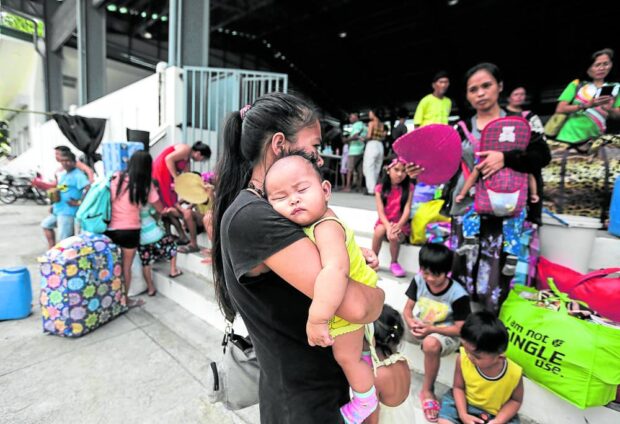Albay folk ‘sleepless’ as lava flows from Mayon

TEMPORARY SHELTER | Residents near the 6-kilometer danger zone around the restive Mayon Volcano are taken to a shelter in Barangay Mauraro, Guinobatan, Albay, on June 9, 2023, in a mandatory preemptive evacuation initiated by the provincial government as the Philippine Institute of Volcanology and Seismology continues to monitor the volcanic activity. (Photo by MARK ALVIC ESPLANA / Inquirer Southern Luzon)
LEGAZPI CITY, Albay, Philippines — From afar, Daniel Lasala, 44, saw the dreaded lava flowing out of the crater of Mayon Volcano, which was facing his hometown of Sto. Domingo in Albay province, around 6 p.m. on Sunday.
The grim sight of the night glow from Mayon, which has been restive for nearly a week now, forced Lasala to immediately ask his wife and four children to prepare their personal belongings and move to his sister’s house in another village.
An hour later, Lasala was knocking on his sister’s door, asking her to let his family stay with them because of the threat of Mayon’s eruption in his village of Lidong, which is around 7 kilometers from the volcano and within the expanded danger zone.
“During the first days of the activity of Mayon, the materials were deposited at Camalig [town] area, but last night, I saw that the lava was flowing in front of our town,” Lasala said in a phone interview on Monday.
Lasala said his family later transferred to the evacuation center, but he stayed at their house to check on their belongings.
Article continues after this advertisementSto. Domingo Mayor Joseling Aguas Jr. said they started the evacuation of families in the villages of Lidong and San Antonio, areas at risk in the 7-km radius extended danger zone, at 5 a.m. on Monday.
Article continues after this advertisement“The residents couldn’t sleep last night, especially in Purok 1 of Barangay Lidong. As early as 2 a.m., I’ve been receiving numerous texts and calls, that’s why we already decided to evacuate them,” Aguas said.
At least 6,000 families from the villages of Lidong, San Antonio, and Sta. Misericordia would be evacuated, the mayor said.
Dome debris
As of noon on Monday, records from the Albay Public Safety and Emergency Management Office (Apsemo) showed that 3,876 families or 13,805 persons were already evacuated, most of them from the 6-km permanent danger zone, since alert level 3 was raised over Mayon Volcano on June 8, indicating an increased tendency toward a hazardous eruption.
Based on the latest record of Apsemo, about 5,817 families, or 21,717 people, were living inside the 7-km extended danger zone.
Around 90 livestock were also evacuated from the towns of Malilipot and Daraga, the Apsemo said.
Paul Karson Alanis, resident volcanologist at the Philippine Institute of Volcanology and Seismology (Phivolcs) Legazpi, said the lava flow caused by the new lava dome shed debris within the gullies in Mi-isi in Daraga town, Bonga in Legazpi City and Basud in Sto. Domingo, about 500 meters from the crater of the volcano.
Alanis said there were no residents directly affected by the debris on the upper slopes of the volcano, as most of the residents inside the permanent danger zone had already been evacuated.
“Its behavior changed [but] I wouldn’t say that this is worse than the past few days. It’s close to the hazardous eruption because it’s under level 3, but now we still can’t see the indication or signal to raise it to level 4,” Alanis said in an interview on Monday.
As of 3 p.m. on Monday, Alanis said they had recorded one volcanic earthquake, 89 rockfall events and continuous lava flow.
Preparations
Camalig Mayor Carlos Irwin Baldo Jr. said they have prepared two additional evacuation centers that would house 2,000 families from the upper portion of the villages of Cabagnan and Salugan, areas within the 7-km danger zone.
The local officials evacuated about 1,000 families from the villages of Quirangay, Sua, Tumpa, and Anoling, areas within the 6- to 7-km danger zone of the volcano.
In Legazpi City, no families were living within the 6- to 7-km danger zone, but residents in the 8-km extended danger zone were advised to prepare for a possible preemptive evacuation.
Phivolcs earlier said volcano debris could possibly affect the southeast portion of the volcano, including the upper villages in the towns of Camalig, Daraga, and Sto. Domingo and Legazpi City.
In an advisory on Monday, Albay Gov. Edcel Greco Lagman said the population inside the 7-km danger zone was placed under preparedness status, which means that evacuation may be ordered anytime.
Eugene Escobar, Apsemo’s chief of the research division, said at a press briefing on Monday that they had deployed vehicles in eight cities and municipalities surrounding the volcano to speed up the evacuation of residents.